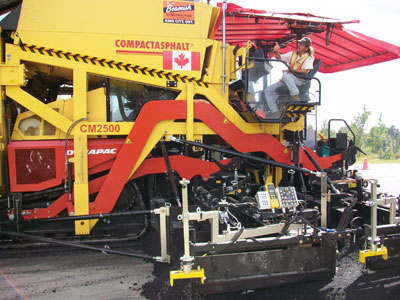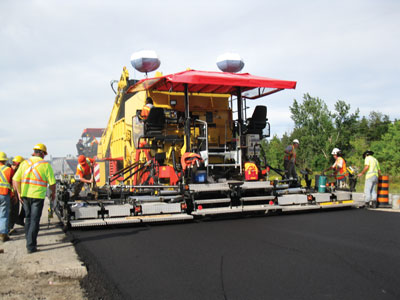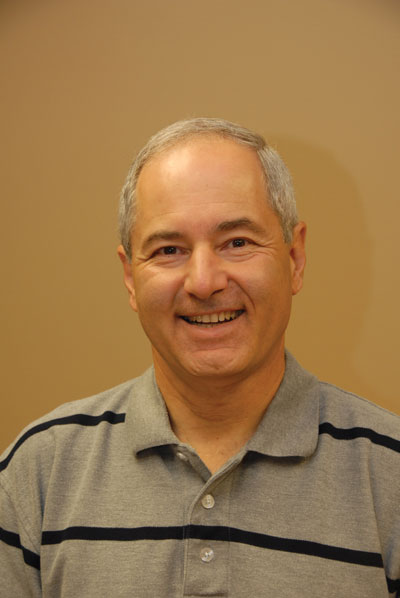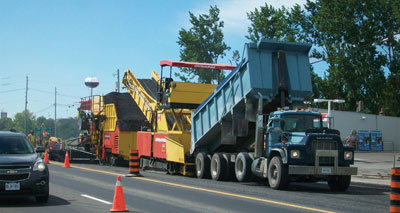
Features
Roads & Paving
Technology
Hot on Hot Hits Ontario
There has been lots of talk about hot-on-hot, or integral two-layer paving, in North America
December 13, 2011 By Bill Tice
To the average driver on Ontario’s Highway 12, this summer’s paving job
looked like any other paving project, and was nothing more than a mild
inconvenience.
To the average driver on Ontario’s Highway 12, this summer’s paving job looked like any other paving project, and was nothing more than a mild inconvenience. But for members of the province’s roadbuilding community it was much more: the results of the project could change the way some road building is done in Ontario, and for that matter, the rest of Canada.
 |
|
| The Dynapac CM2500 in action on Highway 12, north of Toronto. Photo courtesy of K.J. Beamish.
|
The Highway 12 project, which took place on a section of the roadway about an hour and half north of Toronto, included a trial of integral hot-mix asphalt (HMA) paving, a form of paving that is slowly making its way to North America from Europe and Asia. Also known as “hot on hot,” this method of road construction places and compacts two layers of hot-mix asphalt – binder and surface – in a continuous and simultaneous process.
“We see some quality benefits and we see some green benefits of using integral paving, but one of the biggest drivers for us is the potential to significantly reduce closure times during road construction,” says Chris Raymond, head of the Bituminous Section of the Materials Engineering and Research Office with Ministry of Transportation Ontario (MTO). “By reducing closure times during road construction, we not only reduce the inconvenience to the public, but we also reduce our traffic control costs and that means more money is going to pavement instead of traffic control.”
Raymond says he sees the reduced closure times as being a big draw for integral paving if they start to use the process on the province’s larger and busier 400 series highways. “That’s where we could realize some significant cost savings,” he explains. “And with integral paving, we are able to pave two lanes wide, which means on those wider highways we can eliminate the longitudinal joint between the lanes reducing longitudinal cracking and potholes.”
In terms of being green, Raymond says in addition to reduced traffic delays, integral paving allows the roadbuilder to use a thinner surface course of the more expensive and more difficult to source skid-resistant aggregates. “Because the binder course is still hot when you place the surface course, you can make that surface course thinner and create a strong bond between the lifts without the need of a tack coat, which is what would normally be done,” he explains.
In conventional multi-lift paving, a binder course of thickness ranging from 50 millimetres to100 millimetres is placed on top of a gravel base course and then, in a second pass, a 40-millimetre surface course of the more expensive aggregates is typically placed. With hot-on-hot paving, the total design thickness of the HMA is maintained, but the surface course thickness can be reduced to between 20 millimetres and 30 millimetres.
Ontario Trial
For the Ontario trial of hot on hot, the MTO specified hot-on-hot paving within the tender for the Highway 12 project, which was a 6.7-kilometre paving project that also included the use of conventional paving methods.
 |
|
| The Dynapac CM2500 can be used in an extended mode for wider paving applications. Photo Courtesy of MTO.
|
Within the tender, MTO specified that “Integral HMA Paving” needed to be carried out using a recognized system that facilitates the placement of specified thickness of binder and surface courses -– “Hot on Hot.” The tender also specified that for the hot-on-hot section of the project, the paver was to be used in an extended mode, providing a minimum paving width of eight metres for a minimum of one kilometre on the four-lane portion of the roadway.
The MTO tender allowed the bidding companies to go with whatever integral system they chose as long as they could meet the specifications. The Highway 12 contract was awarded to King City, Ont.-based K.J. Beamish Construction Co., Limited. Fernando Magisano, vice-president, technical services for K.J. Beamish, says they decided to work with Dynapac on the hot-on-hot section of the project because they were familiar with the Dynapac equipment and personnel.
“We had a few choices of equipment, including Dynapac equipment, but we had seen a presentation from Dynapac on integral paving at one of the Ontario Hot Mix Producers Association (OHMPA) seminars, and we had seen some articles on the process and the equipment so we were somewhat acquainted with the technology,” he explains.
The Challenge
For Magisano and the paving crews at K.J. Beamish, the project presented an exciting challenge. “At the end of the day, it was another contract, but we were excited to be involved,” Magisano explains. “We knew right off the bat that this would be something new for us and it would be something new for the industry, and we looked at this as a challenge that we wanted to do well. I was pleased with the way we responded, and, I think the ministry was pleased as well.”
 |
|
| Chris Raymond of the Ministry of Transportation Ontario (MTO) | |
 |
|
| Fernando Magisano of K.J. Beamish.
|
K.J. Beamish did not have to acquire the hot-on-hot equipment. Dynapac imported a new machine from Germany and provided it for the test. “They brought in the smaller of the two hot–on-hot machines they manufacture, which is the 2500 Series,” says Magisano. It is the more common machine used in Europe. “Dynapac also brought in a specialized belt feeder, as our standard material transfer vehicles (MTVs) are not long enough or tall enough to feed the second hopper on the machine and they are also not set up to handle two separate mixes. The high-capacity belt feeder supplied by Dynapac allowed us to clean out the hopper completely and quickly between mixes.”
Magisano was impressed with Dynapac’s commitment to the project, noting that they brought a crew of five over from Germany to help assemble the machine once it landed in Ontario, and kept a skeleton crew on hand to help out during the project startup. “I give full marks to the people at Dynapac,” he says. “Right from the start, they supplied us with all of the information we needed and they gave us an insight into what we needed to be prepared for in the bidding process. Their crew spent a lot of time with our crew, working side by side and teaching them the intricacies of the double screed setup and the operation of the equipment. Even though there was a language barrier, it was amazing to see these guys work together, as they understood each other very quickly.”
In addition to the Dynapac crews coming to Canada, K.J. Beamish sent a foreman and its head mechanic to Germany for a week prior to the machine being shipped. The pair observed a crew in Germany that was working on a hot–on-hot project on the Autobahn. “We thought it was really important to get as much hands-on experience as we could,” adds Magisano. “We made the commitment to doing this and we wanted to do it right.”
Although the involvement from Dynapac paid huge dividends in terms of the project’s success, Magisano says not everything went as expected and both K.J. Beamish and the ministry needed to be flexible with the hot-on-hot section of the project.
“The contract was originally designed around our standard paving practices in Ontario, which call for us to come in for short periods of time at night, get the work done, and then get the traffic flow back to normal the next morning,” Magisano explains. “But that wouldn’t work due to the slow cooling curves associated with the thicker paving mats we needed for the hot on hot. Plus we had to allow for the learning curve on the new equipment. Also, we normally allow traffic flow on the side of the roadway that has been completed while we bring up the other lane, but with hot on hot, we can have a 140-millimetre dropoff from one lane to the other, which was a safety concern.”
Logistics
Both the ministry and K.J. Beamish expected to have problems with the logistics of supplying two mixes at the same time – the binder mix and the surface mix, but much to the surprise of both parties, there were a few hiccups, but no major issues.
 |
|
| The hot-on-hot technology was tested out on a paving job on Highway 12, just north of Toronto. Photo courtesy of K.J. Beamish.
|
“The location of the project was good for us,” explains Magisano. “The base mixes were supplied by our Orillia plant, which is approximately 40 kilometres away from the project and has the silo capacity needed to produce larger quantities, and the surface mix was supplied by our Midland plant, which is within the project limits. Even still, keeping a steady supply of base mix was a challenge due to the relative distance, and the required slow production rate of the surface course mix made steady plant production at the Midland plant difficult, but it wasn’t insurmountable and things improved as we went along.”
When asked about the benefits of hot on hot from a contractor’s point of view, Magisano says one of the biggest benefits is compaction. “We were using standard mixes that the ministry normally specifies so we knew what the expected compaction would be at normal thicknesses. But to our delight, we found when we paved to the thicker design specifications of hot on hot, it was much easier to get compaction. Our quality control people observed that when they opened up the cores for compaction they found very few cracked of broken aggregates within the mix, which is unusual because high compaction typically causes aggregate breakdown. And it didn’t matter what width or thickness we were placing, all of the cores came out well within the acceptable range for compaction. Because of this, we see the potential to extend the paving season, theoretically, into the fall when we are facing cooler temperatures.”
Pave-in
Near the end of the test project, OHMPA held a “Pave-in” day where Dynapac, Magisano and Raymond presented their findings and conclusions to more than 85 attendees. The group also visited the road construction site to see the Dynapac 2500 in action. “We had very short notice of the Pave-in day, yet we still had over 85 people participate,” says Michael O’Connor, CEO of OHMPA, which represents 48 producer members in Ontario.
Although there are some significant benefits in using hot on hot, Magisano, Raymond and O’Connor all concede it’s not a process that will work in all situations.
“The limitations include short radius ramps, tapers and intersection fill-in areas,” explains Raymond.
O’Connor says the hot-on-hot process should be used for mainline paving and is best suited to greenfield projects. Magisano agrees, noting that if you use the hot-on-hot paver for what it does well and is designed for, you can get great results. “This equipment would be very effective if you were building a new highway,” Magisano suggests. “If the ministry is willing to shut down long sections of road and let this paver run, it can get a lot of work done in a short period of time.”
Print this page